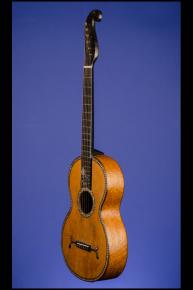An 1850s Markneukirchen "Stauffer Style Parlor Guitar with 'Triangular' Inlays on Body and 'Rose' Inlays on the Fretboard
1850 Markneukirchen "Stauffer Style" 12 fret to body with 'Triangular' Inlays.
This 1850s Markneukirchen "Stauffer Style" 'Parlor' guitar weighs just 2.60 lbs. and has a 11 1/4 inch wide and just under 3 1/2 inch deep, highly figured 'Birds-Eye' maple, ladder-braced' body with a natural spruce top. The body depth at the neck is 2 3/4 inches, the upper bout measures 9 inches and the body length is 17 1/4 inches. The sound hole has a diameter of 3 inches and is bound with walnut, surrounded by two circular 'Herringbone' inlays and a most intricate floral inlay ring (5/16 inch wide) of mother-of-pearl and abalone inlaid onto ebony. The edge of the top also has a 5/16 inch 'triangular design' inlay of mother-of-pearl and abalone inlaid onto ebony with quadruple strip borders of maple and walnut. On the strap-button edge of the body the walnut pin(with a center circle of mother-of-pearl) is situated on a 1/2 inch wide walnut strip.
Ebonized maple neck with 'ice-cream cone' heel and a scale length of 24 inches. The nut width is just over 1 3/4 inches and the 'D' neck profile is nice and thin with 0.77 inches at the first fret, 0.81 at the third fret and 0.99 inches at the ninth fret. Staufer style ebonized single bound maple 'scroll' peghead with original six-on-a side tuner mechanism and circular brass buttons. On the back of the peghead is the fine floral-engraved, brass tuner mechanism cover with nine screws (one replaced). Ebony fretboard with nineteen original? thin frets and neck joint at twelfth fret. From the thirteenth, the length of the frets gradually shortens on the bass side. In this space is the most beautiful 'Rose' inlay of mother-of-pearl and abalone.
Original? bone saddle on 'Double-Moustache' shaped ebony tailpiece with inlaid abalone circles and an ebony 'tear' at each end. Six ivory pins (some not original) with inlaid abalone circles.
There are four cracks on the top, two on the sides and four on the back which have now been repaired and are perfectly stable. The action at the twelfth fret is remarkably low at just 1/8 inch. There is some playing wear on the top but overall this circa one hundred and sixty-five year old guitar is in truly amazing condition. The action is nice and low and the guitar actually plays very well.
Housed in a modern five-latch, shaped black hardshell case with burgundy plush lining (9.25)
"C.F. Martin Sr. (1796-1873 worked for guitar-maker Johann Stauffer of Vienna - and, not surprisingly, a Stauffer guitar from the 1820's looks very much like the early Martins, with its scrolled headstock, six-on-a-side tuner unit, 'moustache' bridge ends, and relatively large upper bout. Martin & Schatz guitars were either made or marketed with Martin's friend from Markneukirchen, Heinrich Schatz, whom Martin followed to the United States in 1833 and who may have had an influence in the development of X-pattern bracing. When Schatz moved to eastern Pennsylvania in 1835, Martin again followed him, buying a home that still stands today in Cherry Hill, just outside of Nazareth." (Walter Carter. The Martin Book, p.19).














